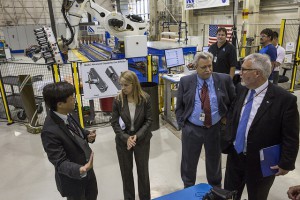From aviation to asteroids to earth science; from advanced composites to autonomous aircraft to bug guts, the men and women of the Langley Research Center are doing amazing things every day – continuing a legacy that spans a century. Last week, I had the opportunity to meet with many of them during an all-hands meeting.

While I’ve only been on the job as Deputy Administrator for a relatively short time, I’ve been a part of NASA’s extended family for decades, and in fact, my second and third spaceflight experiments were funded by Langley under the direction of the great Sherwin Beck. What I’ve long admired about the people at this Center is that the work they do is so cutting edge – and it can have a real impact on all our lives.
Take for example their work on heat shields and thermal protection systems. Next week a team of Langley engineers are headed to Canada to test personal fire shelters with the U.S. Forest Service.
I had the opportunity to tour another example first hand – Boeing’s 757 ecoDemonstrator airplane – which the company flew in partnership with NASA in order to test technologies that can make air travel, cleaner, quieter and even safer than it is today (even as our skies are more crowded).
One of the potential areas for cost savings is insect repellent. As my NASA colleague Christopher Wohl told the Daily Press newspaper, by reducing insert residue (or in less technical terms “bug guts”) from planes’ surfaces “the impact of that across the entire aviation industry can be really enormous.”
I also had the opportunity to talk with Langley team members about the important work they are performing to advance our Journey to Mars efforts. I saw demonstrations of robotic arm grapple research for our Asteroid Redirect Mission (ARM), an incredible robot named ISAAC (Integrated Structural Assembly of Advanced Composites) to further novel composite layups and manufacturing, and impressive unmanned aircraft systems at Langley’s autonomy incubator, which reminded me of a creative campus environment.
I very much enjoyed meeting with senior leadership and new employees and interns alike. The people of Langley are such a big part of the reason that we’re able to say “NASA is with you when you fly” and they are impacting our Journey to Mars and our work to reaffirm America’s leadership here on Earth. How lucky all of us are to be part of such a great team here at NASA who continue to reach for new heights for the benefit of humankind.
